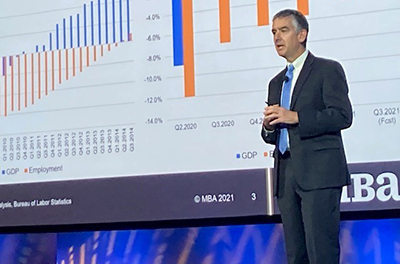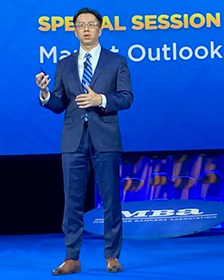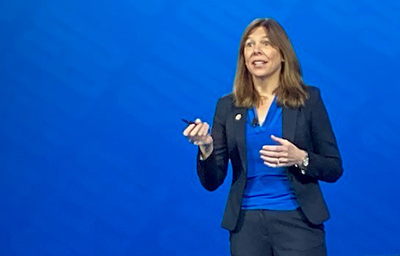
MBA Forecast: 2022 Purchase Originations to Increase 9% to Record $1.7 Trillion

(MBA Chief Economist Mike Fratantoni at the MBA Annual Convention & Expo in San Diego Oct. 17.)
SAN DIEGO–The Mortgage Bankers Association said purchase mortgage originations are expected to grow 9% to a record $1.725 trillion in 2022.
But as purchase applications grow, refinances are expected to further wane. After an anticipated 14% decline in 2021, MBA expects refinance originations will slow further next year, decreasing by 62% to $860 billion from $2.259 trillion in 2021.
The MBA 2022 outlook was presented at its 2021 Annual Convention & Expo by Mike Fratantoni, Chief Economist and Senior Vice President for Research and Industry Technology; Joel Kan, Associate Vice President of Economic and Industry Forecasting; and Marina Walsh, CMB, Vice President of Industry Analysis.
MBA forecasts mortgage originations to total $2.585 trillion in 2022 – a 33% decline from this year. In 2023, mortgage originations are expected to decrease to $2.526 trillion. Purchase originations are forecasted to reach new successive records in 2022 and 2023, while higher mortgage rates and fewer eligible homeowners will lead to further declines in refinance volume.

Fratantoni said the MBA 2022 forecast assumes continued, strong economic growth amidst eventual easing of the supply chain constraints that have curbed some economic activity this year.
“The economy and labor market rebounded in 2021, but overall growth fell short of expectations because of stubborn supply chain issues that fueled faster inflation, slowed consumer spending, and presented challenges in filling the record number of job openings available,” Fratantoni said. “With inflation elevated and the unemployment rate dropping fast, the Federal Reserve will begin to taper its asset purchases by the end of this year and will raise short-term rates by the end of 2022.”
MBA’s baseline forecast calls for mortgage rates to rise, with the 30-year, fixed-rate mortgage expected to end 2021 at 3.1% before increasing to 4.0% by the end of 2022. “Mortgage lenders and borrowers should expect rising mortgage rates over the next year, as stronger economic growth pushes Treasury yields higher,” Fratantoni said.
Robust homebuyer demand from millennial households, households seeking more space and still-low mortgage rates are favorable tailwinds for the housing market in 2022 and are behind MBA’s expectations of record purchase originations over the next two years.
“2022 should be another strong year for the housing market,” Fratantoni said. “Home builders will have more success overcoming current building material shortages and should be able to increase the pace of construction to meet the sizable demand for buying. More newly built homes and more homeowners listing their homes for sale should lead to some deceleration in home-price growth next year. This is good news for the many would-be buyers who are currently priced out or delaying decisions because of low supply conditions and steep home-price appreciation.”

Marina Walsh, CMB.
With home prices reaching record highs over the past year, and more recent new construction being larger and more expensive, average loan sizes have also grown and affordability has weakened – especially for first-time buyers. Kan said he expects some of the affordability challenges to ease as for-sale inventory grows and home-price growth moderates.
“Credit availability is still around 30% lower than pre-pandemic levels,” Kan said. “Mortgage supply will need to increase modestly so that qualified buyers can get access to financing for their home purchase. This will be important for the wave of potential first-time homebuyers who are approaching prime homeownership age.”
Walsh noted the industry is moving away from the record-high, extraordinary production profits of 2020. She said as production volume declines and the market shifts toward fewer refinances and more purchase activity, competition will further stiffen. In this environment, lenders can only chase market share for so long before there are substantial consequences to the bottom line.
“Many lenders will rely more heavily on their servicing business to achieve financial goals. Higher mortgage rates mean fewer prepayments and a longer revenue stream of servicing fees combined with higher mortgage servicing right valuations,” Walsh said. “However, the servicing outlook is more complicated today, with the expiration of many COVID-19-related forbearances and the need to place borrowers into post-forbearance workouts. Servicing costs may rise as servicers work to meet the needs and requirements of borrowers, investors, and regulators.”
“The job market should continue to improve as the pandemic is hopefully behind us, helping to get the economy to full employment by the end of this year,” Fratantoni said. “Household incomes will rise, more homes will be on the market, and home sales should meaningfully increase as a result, even in the face of somewhat higher mortgage rates.”
The MBA updated Mortgage Finance Forecast and Economic Forecast can be viewed here.
